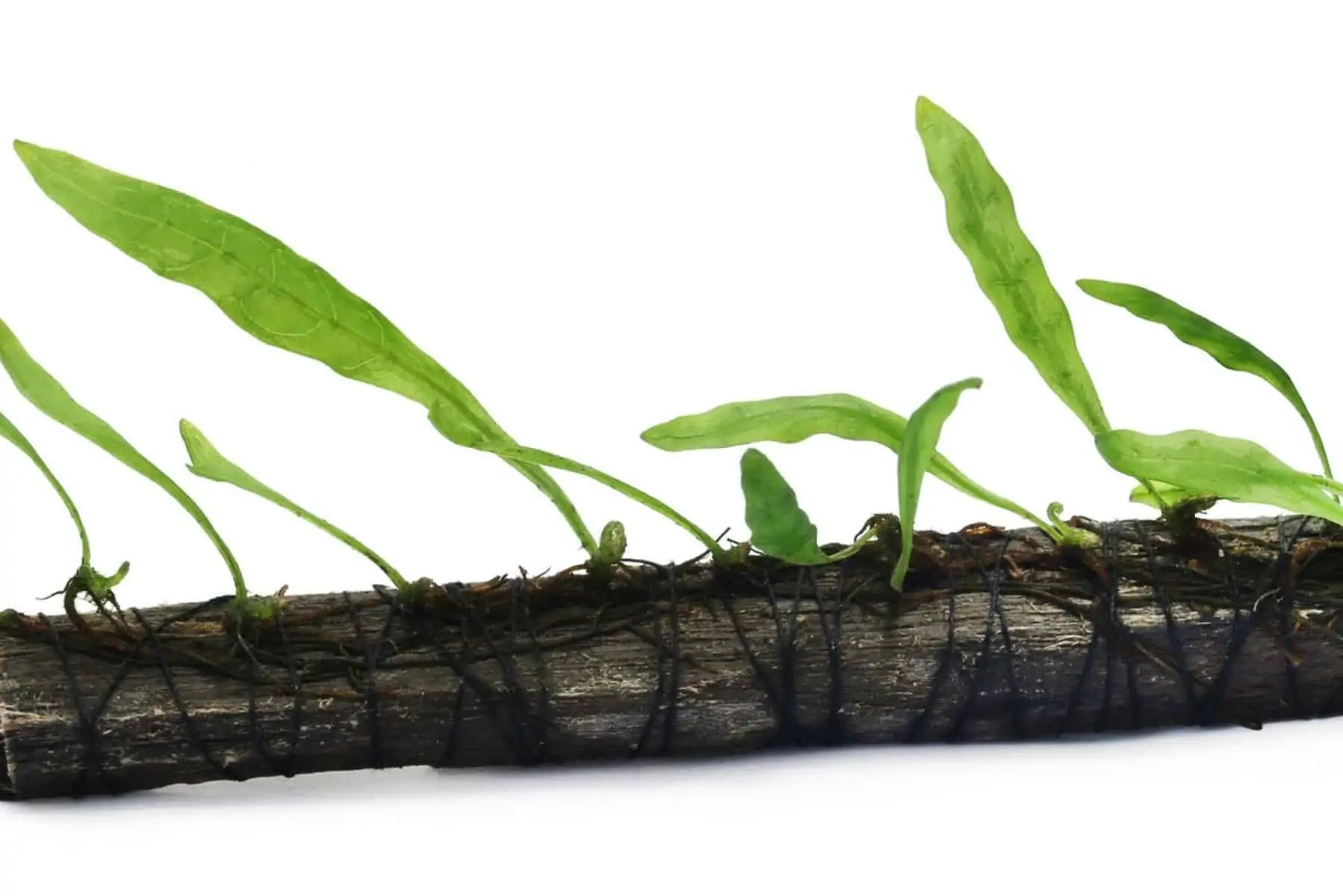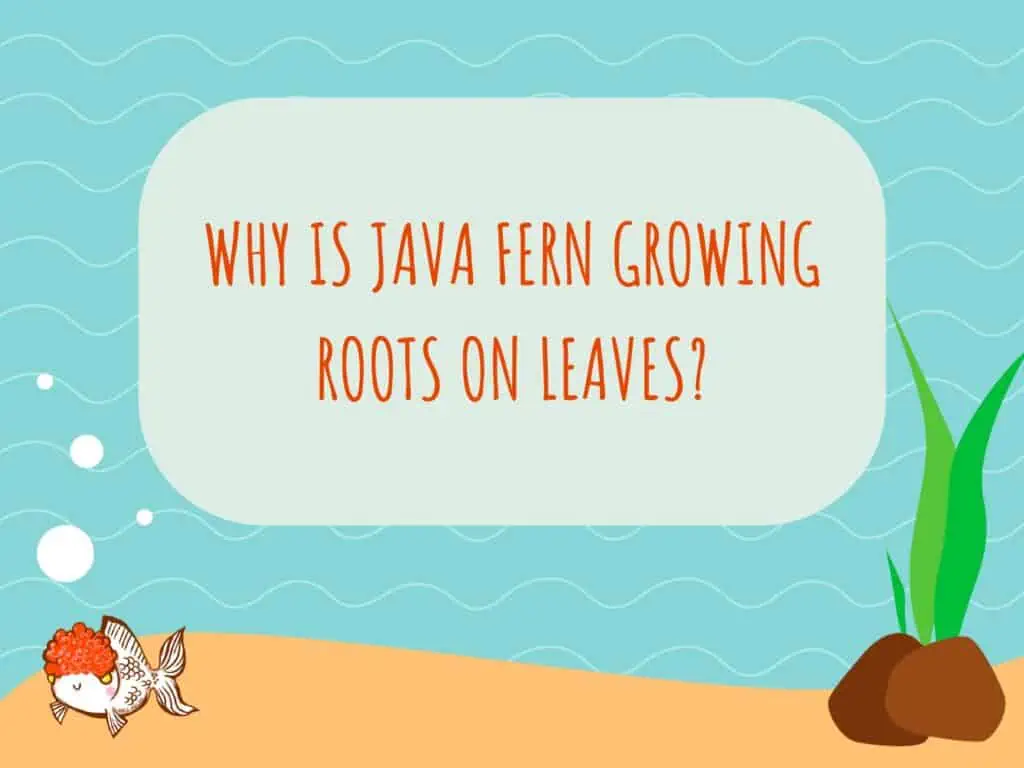Most hobbyists choose to grow aquatic plants in their tanks. Plants bring many benefits to a fish tank, helping to oxygenate the water, taking up harmful ammonia and nitrates for use as nutrients, and offering shade and shelter for the fish and other tank residents.
Java ferns are wonderful plants that you see in many fish tanks. These plants are easy to grow, inexpensive to buy, and super-simple to propagate.
But why do Java ferns grow roots on their leaves, and is that a bad thing?
Read this guide to find out!
Why Does My Java Fern Have Roots On Its Leaves?

Java ferns grow roots from their leaves as part of a natural propagation process that enables the plant to create clones of itself.
The leaves carry spores that help the plant reproduce. So, when a Java fern plant is mature, you’ll see lots of its leaves sprouting roots in a process called apomixis.
Java fern’s long, spear-shaped leaves can grow to around 12 inches long, and the plant uses the roots its leaves put out to anchor it to rocks, wood, etc., to prevent the whole plant from being swept away by the water flow.
Can I Stop the Roots From Growing?
As explained above, Java ferns grow roots from their leaves in a natural reproduction process. If you provide the plant with optimum growing conditions, roots on the mature leaves are a sign that your plants are thriving!
However, the more baby plants that form on the parent plant, the more nutrients they take, which in time, will be detrimental to the parent fern. So, it’s a good idea to remove some of the plantlets for the good of your plant and to keep the tank looking tidy!
Propagating Java Fern Plants
If you want to propagate your Java fern plant, you’ll be pleased to know that it’s easy!
One crucial thing to know is that you can’t grow Java fern plantlets in soil and water. If you cover the plant roots, the leaves will eventually turn black, and the plant will die.
Instead, you’ll need to fix the plantlets to driftwood or rocks to weigh them down and stop them from floating away.
- Use sharp, aquascaping scissors to snip the plantlet from the mother plant.
- Use some fishing line or aquascaping twine to fix the plantlet to a suitable anchoring point.
- Put the plant back into your aquarium and allow two to three weeks for roots to form.
Once the plant is firmly fixed by its roots, you can remove the fishing line or thread.
When removing the leaves with roots from the mother plant, do so at the point they’re attached to the main plant. Always use sharp, sterilized scissors for this job so that you don’t accidentally contaminate the plant with bacteria.
Alternatively, trim off the existing rhizome, cut it in half, and replant it elsewhere in your aquarium.
Do Java Ferns Need Fertilizer?

Java ferns are column feeders, deriving the nutrients they need directly from the water column and through photosynthesis.
That’s one of the benefits of growing plants in your fish tank, as the plants take up ammonia and nitrates from the water, keeping the environment safe for your fish and other livestock.
Under normal circumstances, as long as you give your plants eight to ten hours of light each day, additional fertilizer isn’t necessary.
However, if you want to give your plants a boost, it won’t harm them to add liquid fertilizer to your tank periodically in line with the manufacturer’s directions.
Remember that high levels of nitrates are harmful to your fish, so keep an eye on chemical levels by carrying out regular water tests and making any necessary adjustments. You want the environment to be ideal for your fish as well as for your plants!
FAQs
In this part of our guide, we answer some of the most commonly asked questions about growing Java ferns.
Q: Can Java fern grow from a leaf?
Yes. Java ferns produce roots from a leaf as a means of self-propagation. So, you can grow a whole new plant from one of the mother plant’s leaves!
Q: Can I trim Java fern roots?
Yes, you can trim both the roots and leaves of Java ferns to tidy them up without harming the plant.
Q: Can I grow Java fern as a floating plant?
Java fern is a versatile plant that you can grow floating on the water’s surface. In fact, if any leaves break off the main plant, they will continue absorbing nutrients and growing while floating on the surface.
Q: Can Java fern grow planted in soil?
Java ferns are epiphytes, meaning they can’t survive if planted in soil or any kind of substrate.
Essentially, the soil prevents light from reaching the plant’s rhizomes, and the leaves wither and turn brown.
Instead, grow the plants as surface floaters or attach them to pieces of driftwood or rocks with fine thread and watch them thrive!
Q: How much light do Java ferns need?
Like all plants, Java ferns need light for photosynthesis. High-intensity light and overexposure can damage the plant, so we recommend exposing your ferns to light for between eight and ten hours daily.
Q: How quickly do Java ferns grow?
Java ferns are slow-grower plants, attaining around an inch or so each month. So, your plants will take up to one year to reach their full size of between 6 and 13 inches.
However, if you want to accelerate your Java fern’s growth rate, try adding CO2 and some liquid fertilizer to your aquarium.
Q: Do Java fern plants remove ammonia and nitrates from my fish tank?
Yes, like all underwater plants, Java ferns use ammonia and nitrates as fertilizers, which is a great reason to keep live plants in your tank!
Q: Why are my Java fern’s leaves turning black?
If your Java fern’s leaves begin to turn black, that’s most likely because they lack nitrogen. Other causes of sickly Java ferns can include high light intensity, melting, and plant rot.
Final Thoughts
Did you enjoy our guide to why Java fern plants grow roots from their leaves? If you did, please share the article with other keen aquascapers!
Java ferns are lovely plants that many hobbyists like to include in their fish tanks. These plants are beginner-friendly and relatively easy to grow, helping to keep your tank water clean by taking up harmful chemicals, using CO2, and producing oxygen.
One way that Java ferns propagate is to grow roots from the leaves of adult plants. So, if your ferns do that, don’t be concerned; you know you’re simply providing the plants with optimum growing conditions!
What aquarium plants do you grow in your tank? Tell us in the comments box below!


